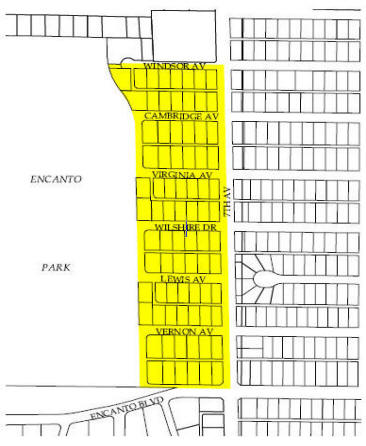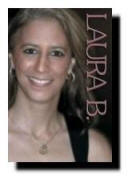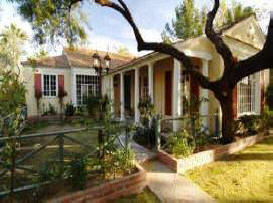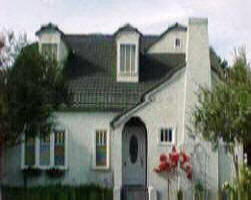Encanto Vista
Historic District Map, History, Information and Homes
For Sale

DEVELOPMENTAL HISTORY
Encanto Vista was
part of a 320-acre tract of agricultural land purchased
by Phoenix merchant James W. Dorris just after the turn
of the 20th century. Dorris built his home on the tract
which was then outside the city limits. His house on N.
7th Avenue still survives. As the city grew out to meet
him, Dorris sold different parcels for residential
development. Among them were the prestigious
Encanto Palmcroft and
Encanto subdivisions
to the south of Encanto Vista. In 1943, Dorris sold most
of his remaining property to the Hamman Lumber Company
with the caveat that they build a high class
development, a condition that he had placed on his
earlier ventures (Weight, March 3, 2003). By insisting
on restrictive covenants and minimum lot prices, Dorris
virtually guaranteed that these subdivisions would
attract only well-to-do residents. Since his own home
lay immediately north of Encanto Vista, he also ensured
that his neighbors would be of his social and economic
class. Dorris's measures laid the groundwork for Encanto
Vista as a Picturesque Neighborhood (1911-1955) whose
appeal lay in its exclusivity and aesthetic qualities.
When the Hamman Lumber Company filed a plat for
Encanto Vista in 1943, they knew they wouldn't be able
to build until after the war due to restrictions on
"non-essential" housing. Nevertheless, the property was
an attractive tract that promised success in the postwar
period. To the south lay the upscale Palmcroft and
Encanto subdivisions and to the west lay Encanto Park, a
city park acquired from Dorris in 1937. The 100-acre
Encanto Park featured an island lagoon, lush vegetation,
a clubhouse, and two golf courses (Weight, March 3,
2003), one of which bordered the
Encanto Vista site.
The high tone of the
Encanto neighborhood
and the park amenities would prove enticing to home
buyers.
Since it was already platted in 1943,
Encanto Vista was
ready for construction when restrictions were lifted at
the end of the war. Construction commenced immediately
with the first homes completed in 1946. By 1949,
seventy-two percent of the lots were built out with
another fifteen percent holding building permits. The
subdivision was nearly complete by 1951 with a few later
houses constructed between 1958 and 1959. Among the more
than fifty builders who constructed homes in the
district were Alfred Anderson, Del Webb, Sam Hoffman,
and Clarence Crittenden. Many of the houses were
architect-designed. Among those who contributed to
Encanto Vista were Peter Hauskens, David Shoulder, and
Frederick P. Weaver.
A Picturesque Neighborhood in the tradition of
Encanto Manor, Los Olivos, and
Encanto-Palmcroft,,
Encanto Vista was
well-planned to benefit from the attractive green space
of
Encanto Golf Course/span>.
Streets were designed in an unusual repeating horseshoe
pattern to provide views to the greatest number of
residents, achieving a park-like setting for its custom
and semi-custom homes. Houses and lots were large;
houses averaged 1,900 square feet and lots averaged
one-fifth of an acre. A sense of cohesiveness was
achieved through standard sized houses and lots and
setbacks of 30 feet. Unity was further gained by the use
of similar building materials such as brick, block,
asphalt shingles, and casement windows (Weight, March 3,
2003). In contrast, many different architects and
builders contributed to Encanto Vista's housing stock,
adding variety to the predominant Ranch style. They
included glass block, bullseye windows, varied wall
patterns, bay and corner casement windows to create
variety and texture in an otherwise uniform setting.
Development in
Encanto Vista
represents the transition between pre-war construction
trends, in which many different contractors built
individual homes for specific clients, and later postwar
patterns, in which developers built large tracts of
similarly designed houses on speculation. Following
pre-war tradition, many different builders and
architects contributed to Encanto Vista's development, a
fact that resulted in a variety of design motifs and
materials. On the other hand, the district embraced new
concepts in subdivision development and was laid out on
similarly sized and shaped lots with one-story masonry
houses. Though individual houses possessed unique
attributes, nearly all were variations on the modern
Ranch style. Also, like many of the new postwar
neighborhoods, nearly one-fourth of Encanto Vista's
homes were built on speculation.
Encanto Vista differed in other ways from the
typical postwar home in Phoenix. House lots in Encanto
Vista are generous, averaging approximately one-fifth of
an acre and measuring about 65 feet wide by 130 feet
deep. Large lots accommodated significantly larger
houses than the average postwar tract home. The average
house size in the neighborhood is 1,900 square feet
compared with only 1,250 square feet for the average
single family house in Phoenix at the time. And, it was
much larger than the typical single-family home built in
the United States which averaged less than 1,000 square
feet. Also, the average post-war house in Phoenix had
five rooms and one bathroom while the typical Encanto
Vista house had six rooms and two bathrooms.
Additionally, more than two-thirds of houses in Encanto
Vista had a garage at the time of construction compared
with only twenty percent of houses throughout Phoenix.
All of these factors further illustrate Encanto Vista's
upscale characteristics.
Both pre-war and postwar subdivisions touted
amenities to attract buyers. In the early 20th century,
developers advertised streetcar access, city utilities
and lack of city taxes to draw potential home owners. In
the postwar period, developers enticed potential buyers
with access to schools, hospitals, and shopping centers.
A major selling point for Encanto Vista was its location
near a major public park and golf course. Encanto
Vista's streets, with their east-west horseshoe plan,
were laid out to allow views of the golf course. No
house was more than a block from the green space and one
real estate agent advertised a house in the subdivision
as being only half a block to the eighth tee of the
Encanto Golf Course. Nearby Encanto Park was also a
selling point to young families with children. After the austerity of the Great Depression and the
war years, many would-be householders longed for a new
start and eschewed older used homes and neighborhoods.
Encanto Vista offered a fresh, new neighborhood with
modern houses built in the fashionable Ranch style.
Houses in the
Encanto Vista Historic
District are all variations on the Ranch
style which dominated residential design after World War
II.
Encanto Vista's Ranch style
houses are all one story, a hallmark of the
design. Most feature hipped roofs and steel casement
windows. Virtually all of the district's houses are
masonry with more than two-thirds rendered in brick with
the rest constructed of painted or stuccoed block.
Variations on the Ranch style found in the district
include French Provincial, as typified by the Clarence
Crittenden House at 718 West Cambridge, International
Style as found in the Howard Boice House at 727 West
Windsor Avenue, and the Early Ranch, like the Shaw House
at 706 West Virginia Avenue. Brick patterns and tile
roof ridge caps are common ornamental features found in
Encanto Vista.
Information, maps provided courtesy: Historic
Preservation Office of the City of Phoenix
Neighborhood Services Department 200 West Washington
Street
Phoenix, Arizona 85003
When developers planned Encanto Vista, they zeroed in
on a key selling point for the neighborhood: Encanto
Golf Course. Decades later, that amenity is still a
favorite among some residents.
Encanto Vista is among the smaller historical
neighborhoods in Phoenix, with about 80 homes shoehorned
between Seventh Avenue and the golf course. When
original landowner James W. Dorris sold the property in
1943, he decreed that the new owner build only a
"high-class development," city records show. Indeed, the
neighborhood's large lots and homes immediately
attracted a Phoenix mayor, prominent architects,
business leaders and others.
|

Laura Boyajian
Mobile: 602.400.0008
HistoricCentralPhoenix@cox.net
HomeSmart, LLC
5225 N. Central Ave. #104
Phoenix, AZ 85012
(602)
400.0008

|



